Excerpts from Jim Conrad's
Naturalist Newsletter
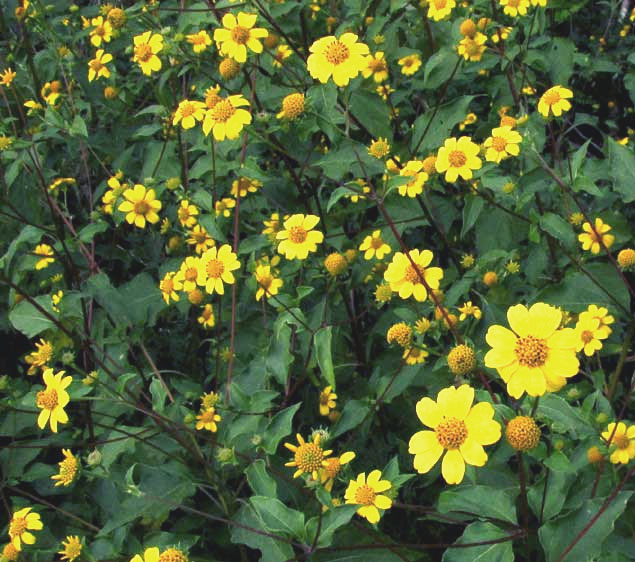
from the January 2, 2011 Newsletter issued from Hacienda Chichen Resort beside Chichén Itzá Ruins, central Yucatán, MÉXICO; limestone bedrock, elevation ~39m (~128ft), ~N20.676°, ~W88.569°
SUNFLOWER GOLDENEYES IN SUN & WIND
Hiking to Pisté to buy bananas and oranges I decided to check out an abandoned field along the way. Back in college I had a special interest in "old field succession" -- how distinct communities of plants successively displace one another between when a field is abandoned and when it reverts to a secondary woods. This time last year the Pisté field had been covered with knee-high annual herbs and grass, so what would it look like this year?
The change was striking. The most conspicuous plant, in some places forming house-size thickets, was a bushy, eight-ft-high (2.4m) member of the Composite or Sunflower Family absolutely loaded with inch-wide (2.5cm), yellow blossoms. It was a dazzlingly sunny day with a stiff breeze, and how pretty it was to stand beside the plants watching their golden heads heave in the wind. You can see a small part of a plant at the top of this page.
The other day a visiting botanist told me that the Yucatán's composites -- plants in the Composite or Sunflower Family -- were driving her crazy, since there are no field guides or identification keys for them. One reason the Composite Family is such a challenge is that there are so many of them. In the adjacent state of Quintana Roo about 90 species in the family have been listed, and there must be a similar number here. In Quintana Roo the Composite Family is the third most diverse family, after the Bean Family (±146 species) and the Grass Family (±101 species).
Composites are a problem for me, too, but that day I decided to try on this spectacular species.
Keeping in mind the key field marks distinguishing genera and species in the Composite Family, I systematically noted the yellow-flowered bush's features. First I looked beneath the flower head and saw that the green scales, or phyllaries, overlapped one another in three or so series, and were expanded at their bases and with sharp, herbaceous tips, shown below:
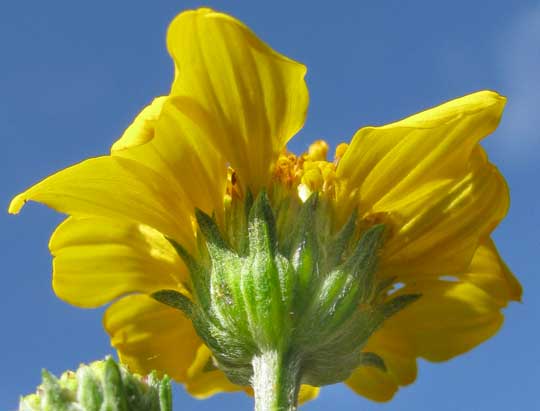
Next I broke apart a flower head to see if individual flowers inside the head were separated from one another by scales (also called bracts or paleae). I found many unusually wide, sharp pointed ones, shown below:
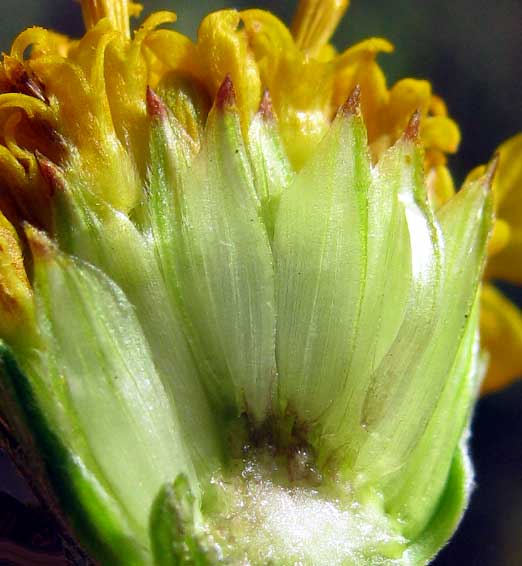
Next I needed to know what kind of "pappus," if any, crowned the plant's one-seeded, seedlike achene-fruits. Pappi on mature achenes eventually mature into fuzzy, wind-catching parachutes, spines that stick into fur, or several other configurations, all designed to help the fruit get disseminated. You can see what I found atop three achenes below:
 .
.
Each achene bore a pappus in a different state or repair. The pappus of the one on the left is complete, consisting of two long, sharp, broad-based spines, plus a crown of four or so jagged-topped (lacerate) scales, and these surround the old, drying-up disk- flower about ready to fall off. On the middle achene the flower and one long, sharp spine have fallen off. On the achene at the right just the crown of four or so lacerate scales remains. Maybe these sharp-pointed scales help the achenes stick to passing animals.
Finally I looked at the leaves, and one is shown below:
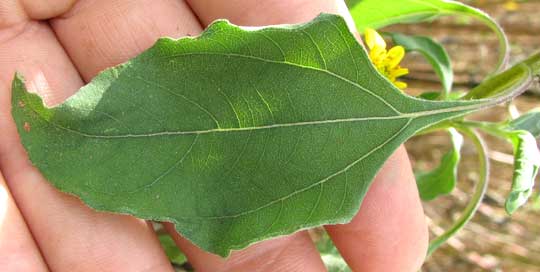
The leaves are conspicuously three-nerved from their bases, plus their blades form "wings" extending part of the way down the petioles. Leaves on the plant were all "alternate" -- one leaf per stem node -- but scars on the stem at the plant's base indicated that the first leaves may have been "opposite" -- two leaves per stem node.
With these field marks noted and documented I was able to get a name, thanks especially to the fact that the species also occurs in the US's southwestern desert, so the species is keyed out and described in the online Flora of North America.
Among the plant's English names are Sunflower Goldeneye and Toothleaf. It's VIGUIERA DENTATA, a genus that on the phylogenetic Tree of Life stands near the sunflower genus Helianthus.
It also grows in Cuba and Central America. In this part of the world it's pretty common in weedy areas.
from the January 22, 2012 Newsletter issued from Hacienda Chichen Resort beside Chichén Itzá Ruins, central Yucatán, MÉXICO; limestone bedrock, elevation ~39m (~128ft), ~N20.676°, ~W88.569°
YELLOW ROADSIDES
Nowadays the road south of Pisté toward Yaxuná is resplendent with a yellow-flowered, weedy wildflower sometimes called Sunflower Goldeneye, Viguiera dentata. You can see how the yellowness just stretches on and on below:
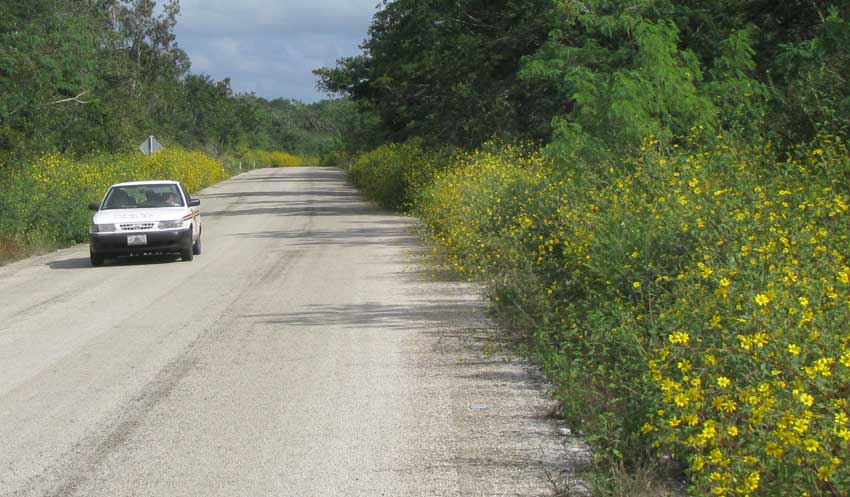
from the March 4, 2018 Newsletter issued from Rancho Regensis north of Valladolid, Yucatán, MÉXICO;
elevation ~40m (~130 ft), N~20.876°, W~88.170°
SUNFLOWER GOLDENEYES DRIED UP
At this moment in the dry season when moisture from the rainy season finally has been reduced to the point that soil here no longer can support herbaceous annual plants, those yellow walls have turned into brown walls, as you can see on the road between the rancho and Ek Balam shown below:

Most of the brownness is provided by dead leaves and stems, but at branchtips the flowering heads that once blossomed in such profusion now have become stiffly dry, brown fruiting heads, as shown beflow:
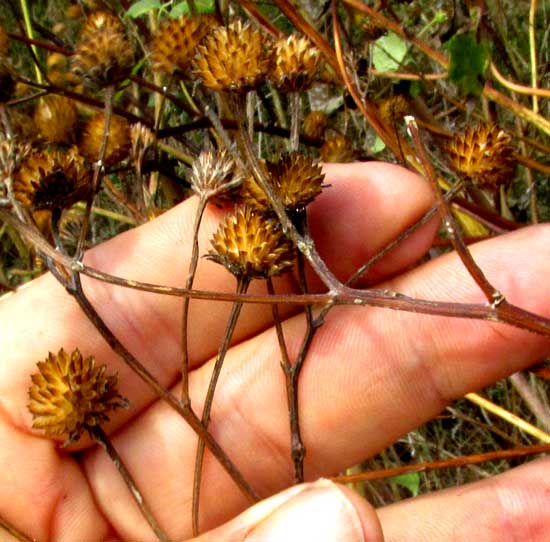
Next season's show of Sunflower Goldeneyes are being sown by these heads right now. Wind shakes the stems and hard, little fruits tumble onto the soil. Gradually the parched-brittle stems deteriorate, crumbling to the ground, little by little allowing the similarly super-abundant Wild Tamarind or Uaxim trees reclaim the visual dominance they command for about nine months of the year. Our Wild Tamarind page is at www.backyardnature.net/mexnat/leucaena.htm
from the January 25, 2019 Newsletter issued from Rancho Regensis north of Valladolid, Yucatán, MÉXICO;
elevation ~40m (~130 ft), N~20.876°, W~88.170°
THE SEASON FOR YELLOW FLOWERS
The Sunflower Goldeneyes' individual flowering heads turn to face the sun, just as regular sunflowers do. If you look at the blossoms from the side, the "wall effect" vanishes, as shown below:
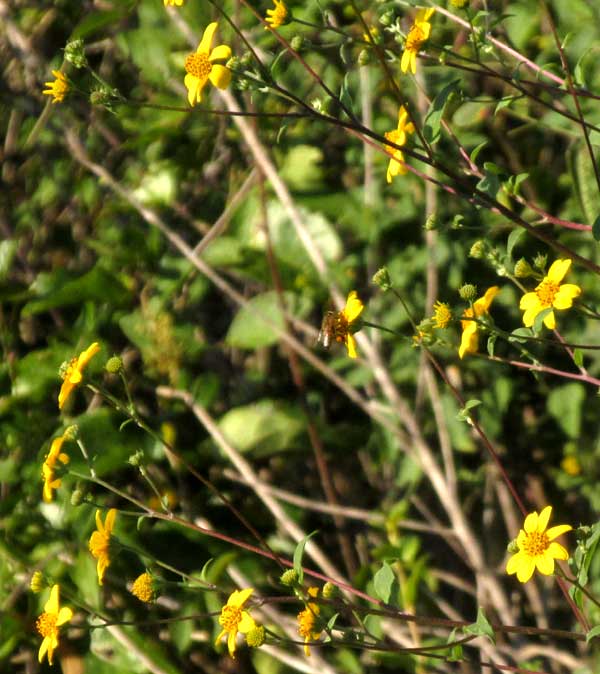
While taking that picture, I noticed that other yellow-flowered species had chosen this exact season in which to blossom, too. For example, below you can see dry-season-leafless but brightly yellow flowering Silk Cottontrees rising over a wall of Sunflower Goldeneyes:
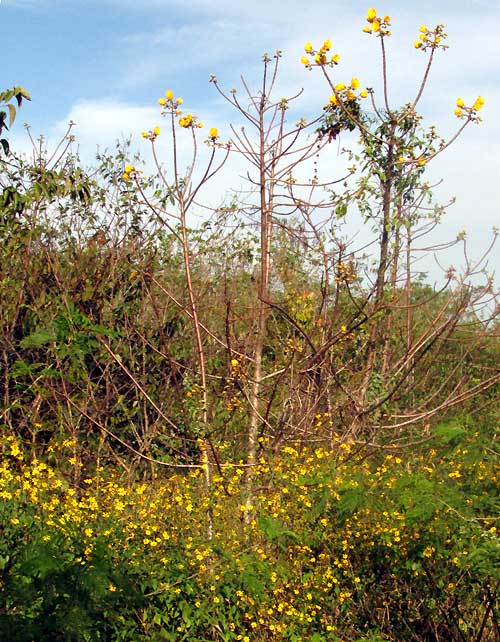
You can check out those Silk Cottontrees on our page at www.backyardnature.net/yucatan/cochlosp.htm
Once the Silk Cottontrees' contribution of the exact same hue of yellowness as the Sunflower Goldeneyes' was noticed, I looked around and saw that all along the road Twin-flowered Cassia trees similarly were offering up that same bright yellow hue. You can confirm that on our Twin-flowered Cassia page at www.backyardnature.net/yucatan/senna2.htm
Also along the road the Aldamas were flowering with the same yellowness, as seen at www.backyardnature.net/mexnat/aldama.htm
What is it about this season that encourages plants to adorn the green landscape with the brightest hue of yellowness? Ecologically, this exact stage of the dry season is special because soil still holds a little moisture from the rainy season, but now that moisture is about to disappear, plus the air will start getting hot and dry fast. Already some of the herbaceous layer is dying back, and deciduous trees are losing their leaves.
This opens up the forest and roadsides to more light and wind, even as the landscape pales from its rainy-season vivid dark greenness, taking on tones of brown and gray. And my subjective judgment is that in this particular environment, no color shows up better than yellow.
So, this is the last chance for species to use what's left of soil moisture to sustain flowering and fruiting, and those fruits must get their job done now if there will be seeds ready to germinate when the rainy season returns in May or June.
That's just my guess. The main thing I wanted to celebrate here, though, is just that these days constitute a special season that it would be a shame to overlook.